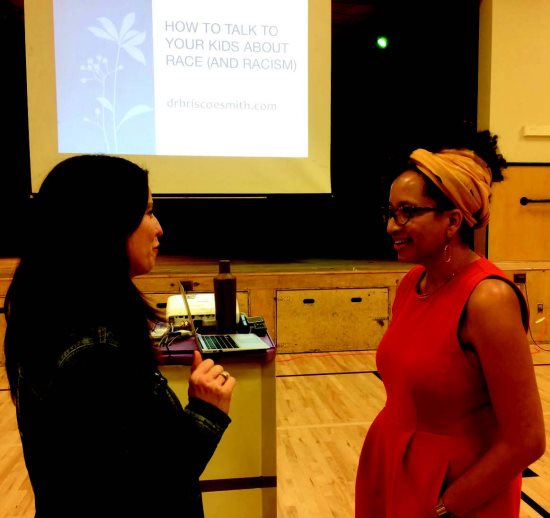
| ||||||
That and other startling facts - as well as instructional tools with which to engage children about racial relations - were the subject Oct. 16 of a Lamorinda Moms speaking event, "How to Talk to Your Kids About Race." The program introduced Briscoe-Smith, who received her undergraduate training in social psychology from Harvard University and holds an M.A. and a Ph.D. in clinical psychology from UC Berkeley. Her specialty is treating patients whose trauma is experienced at the intersection of poverty and racism. A frequent public speaker, trainer and consultant, Briscoe-Smith addresses the compound negative forces that interrupt and impact relationships. She is the mother of three children, ages 1, 8 and 9.
After asking the approximately 75 adults gathered in the multipurpose room at Orinda Intermediate School to share their first race-related memories with a nearby seat mate, Briscoe-Smith said, "We can engage in dialogue about race. It is doable." Moments later, she issued a caveat: "But we're not fluent in the conversation and that communicates something to kids."
Often, hesitant to discuss a topic fraught with tension and, perhaps, to sidestep a raw, unwelcome glimpse at their own implicit bias, parents avoid speaking about race with children. They are afraid to make a mistake. They wonder, what if I bring it up too soon? What if I traumatize my son or daughter with warnings of how awful a world with systemic and implicit bias can be? What if I say the wrong thing? That would mean I'm a racist. They'll think I'm a bad person.
It's not just parents who worry; teachers hesitate, afraid they'll lose their jobs or unsure of the best methods to integrate the topic of race into classroom curriculum.
"We're gonna make mistakes," said Briscoe-Smith. But not speaking isn't a solution, because adult silences also instruct. "Our kids are wired to learn from whether or not we're comfortable talking about race," she said. Instead, frequent engagement, not making it "a race talk," much in the same way discussions about sex must not be "one-off" conversations, she said is most effective. Parents are already conveying daily lessons about acting, speaking and thinking with compassion, kindness and social justice. Breaking it into manageable chunks and pacing the conversation to suit a child's developmental stage and temperament are all useful approaches. Parents granting permission to kids - and to themselves - to admit, "I'm not sure what to say," or "I don't have all the answers but I believe it's really important to talk about it," is essential.
Although there are no fast, perfect and easy solutions, there is plenty of science to support diving in at a young age. Exactly when to begin talking with children about race was the primary concern and question repeatedly asked by the audience during Briscoe-Smith's presentation.
By age 2-and-a-half to 3, children display preference for heterogeneous peers. Disturbingly, black children as young as age 4 begin to indicate white preference and attribute positive characteristics to white dolls and negative response to black dolls. Despite desegregation and other markers of social justice and civil rights achievement, Briscoe-Smith said the doll studies originally conducted to establish Supreme Court rulings regarding segregation were replicated in 2014 and had the same results. It all adds up to what author Beverly Daniel Tatum refers to as "The Smog," a harmful, pervasive environment of racism in America that has real, long-term health consequences for children and adults.
The media doesn't help. Research shows black fathers are more involved in parenting than other families, but media from Fox News to CNN over-represents black male's criminality, poverty and lack of family involvement. And although there are roughly 600,000 more black Americans in college than in prison - and since 1970, black Americans with high school degrees have jumped from 31 to 70 percent, according to data presented by Briscoe-Smith - media misinformation continues. Across teachers of all demographics, students who are people of color are disciplined more often than white children, are met with low expectations or are expelled from schools.
People asked if counter-stereotype or empathy training is effective in breaking down systemic and implicit bias. Briscoe-Smith said she and other experts have found the training doesn't last more than 24 hours because "we're still in the smokestacks." Meaning, people live in an environment of implicit racism and therefore quickly revert to established patterns. Defensiveness prevents people from honestly evaluating their own implicit bias. "Saying, 'I'm sorry I've done some harm,' is different than, 'I'm sorry you took offense at that.' It pushes the responsibility onto the other person," she said.
Of course Briscoe-Smith also offered words of hope. A colleague who conducted training at Berkeley High School had strong early results that faded by the end of the first year. But repeated a second year, the training stuck and proved with repetition and time, "moving the smog" of racism is possible.
For teachers and administrators, she recommended staff-wide education about implicit bias and one-on-one training for classroom applications. Schools and entire districts that develop strong mission statements and hiring policies that reflect diversity and inclusiveness - and develop programs to support those mandates more often than one month or one day per year - establish for students that every child belongs and is valued.
For parents concerned about framing the conversation, Briscoe-Smith offered ideas and resources: develop a family mission statement; practice and model mindfulness that slows reactivity and enables intentional, aware-of-difference perspectives, especially when speaking to or about other people and events in the context of race. Resources offered at Embrace Race's website and others offered at her website (http://www.drbriscoesmith.com/resources/) are good places for parents, teachers and adults who work with children to become educated about these must-have, ongoing conversations.
For more information, visit
www.lamorindamoms.org or
www.drbriscoesmith.com/home.
Reach the reporter at:
